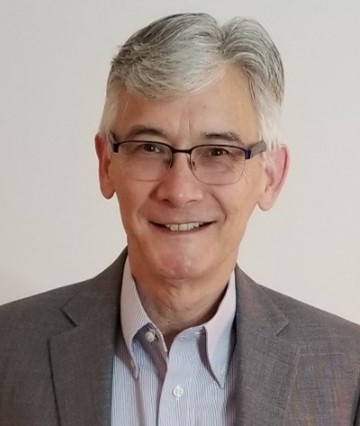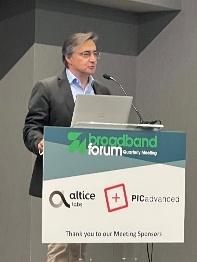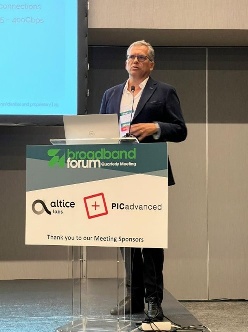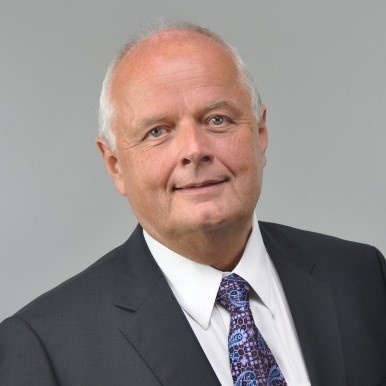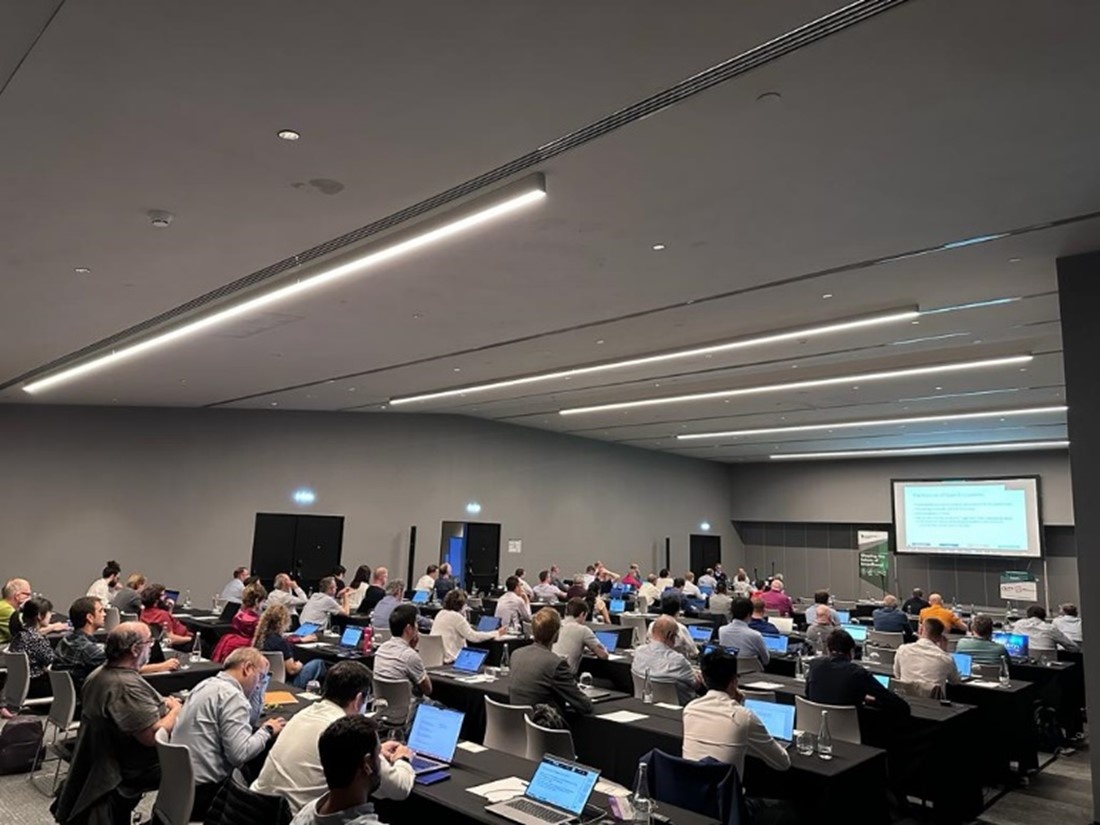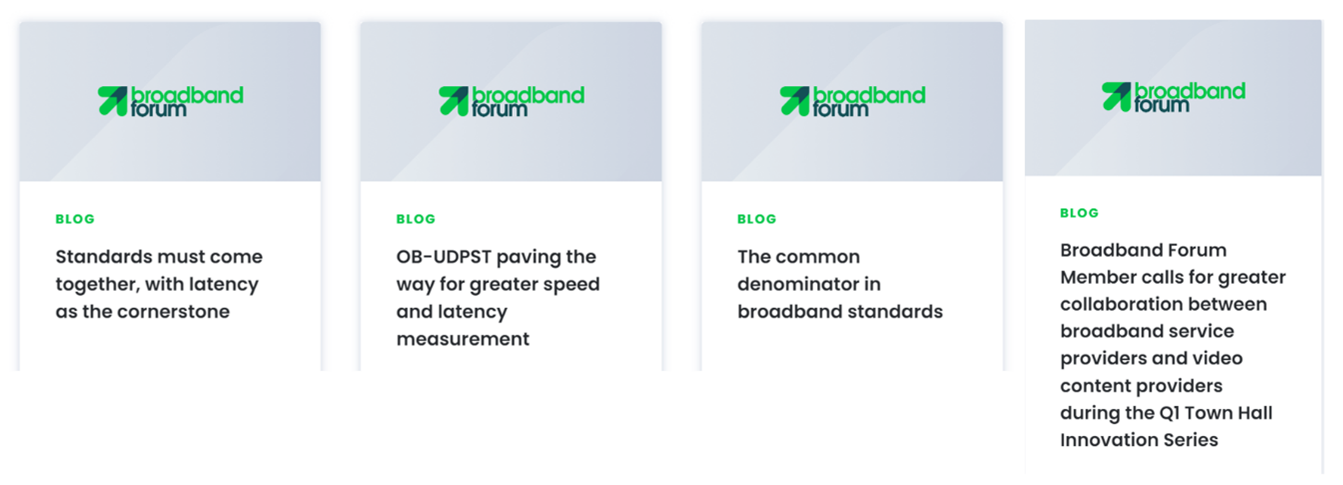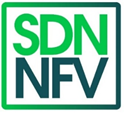____________________________________
Work Area Updates
For a full list of all Technical Reports approved by the Broadband Forum, click here. Please feel free to share this information with your colleagues, so they are engaged and aware of the developments of this work. For additional insight and to get involved, sign up for the members-only Broadband Forum tools and access your account using your company email address.
ATA - Brainstorming and marketing to follow!
Target: The Access & Transport Architecture work area maintains the primary architectural work of the Broadband Forum. This work reflects the control, management and data plane aspects of the Broadband Forum’s defined and new architectures. These architectures are augmented to leverage new industry practices, while protecting the investment in broadband networks already deployed.
Outcomes:
- Access Architecture Project Stream - TR-459i2 Multi-Service DBNG was published.
- Access Architecture Project Stream - MR-459.4 CUPS for a Disaggregated BNG: Objectives and Scope was published.
- Performance, Experience, Application Testing Project Stream - TR-452.5 Quality Attenuation Measurements Using L2 PM OAM starting Final Ballot.
- Performance, Experience, Application Testing Project Stream - WT-452.6 Applicability of IOAM in Supporting QED Measurement started.
- Performance, Experience, Application Testing Project Stream -WT-471i4 IP Capacity Metrics and Measurement sent to Straw Ballot.
Progress:
- Access Architecture Project Stream - WT-459.2i2 Multi-Service Disaggregated BNG with CUPS: Integrated Carrier Grade NAT function. Reference Architecture, Deployment Models, Interface, and Protocol Specifications revision started.
- Access Architecture Project Stream - WT-474 Subscriber Session Steering project continuing YANG data modeling project (YMSSS) for the entities and relationships defined in the document. Work has been completed offline via BitBucket.
- Access Architecture Project Stream - WT-487 DBNG for Wired Access is under development. The protocol debates continue.
- Access Architecture Project Stream - WT-497 WiFi Authentication is under development.
- Performance, Experience, Application Testing Project Stream - WT-452.4 QED Measurement Formats progressing via BitBucket and markdown.
- Performance, Experience, Application Testing Project Stream - WT-452.3 Quality Attenuation Conformance Testing is in progress.
- Performance, Experience, Application Testing Project Stream - WT-499 Service Metrics contribution in progress.
- ATA Marketing Group – See Join or Leave BBF Groups and Email Lists to subscribe.
We had a great meeting with good progress made across our projects!
New ideas: We had our first brainstorming session in quite a while which resulted in a good start of listing potential new work items and activities - please keep it going! We compiled the list of ideas on the new idea wiki page and each idea will eventually be broken out into its own wiki page for further development, if you have more ideas to add, please do so! If you are interested in participating in work related to one of the ideas, please feel free to reach out to the listed contact and get involved.
ATA Marketing: One key point raised during the brainstorm was the enthusiastic re-commitment to marketing of ATA work, the work that can potentially be done in ATA, and work that can potentially be done in the Forum. As we said in the meeting, we are doing great work, but if we don't tell anyone, it will just sit on a shelf and collect dust. Jon and I will be working with Craig Thomas offline to set up what we need to kick off productive activities and deliverables immediately following the meeting. Stay tuned on the ATA marketing email list for more on this important topic and please reach out to marketing counterparts in your respective companies to help out.
Lastly, as noted in our Q4 2022 and Q1 2023 meetings, we agreed to hold an ATA interim meeting later in 2023. The particulars will be posted on the ATA email list and the wiki. Many have expressed their recognition of the critical nature of meeting in-person, in particular to work out difficult issues, and formulate approaches to progress and establish new work. The interim meeting allows an additional opportunity to do such, as well as generally foster a productive team working environment. While we will continue to allow remote participation, we strongly encourage attendance in-person to leverage these opportunities, especially at the quarterly meetings.
See the Closing Plenary slides for details but above are some highlights.
For more information on ATA Work Area’s ongoing work, visit: Access and Transport Architecture home page.
USP version 1.3 and TR-181 Device:2.16 published, next up is the operator-grade smart home
Target: Explore the necessary work for delivering an operator-grade smart home
Outcome: Detailed contributions in the new Smart Home Project Stream
Building on the successful publication of USP version 1.3 and TR-181 Device:2.16 – both of which form the basis for application-enabled services using broadband CPE – the Broadband User Services (BUS) work area set its sights on its latest endeavor: delivering an operator-grade smart home ecosystem.
The Smart Home project stream is designed to provide the tools to empower operators to assist in the deployment, management, and interoperability of the smart home. This will be achieved by using USP (TR-369)/TR-181, as well as introducing requirements and test plans for the network and security capabilities of the smart home devices deployed in subscriber networks. Contact the project stream leads, Jason Walls and Tim Spets, to get involved.
The group is also finalizing the most recent performance metrics for the widely used TR-398 Wi-Fi performance test plan. Once these proposed metrics have been thoroughly tested and approved, the third issue of the specification will promptly follow.
BUS is happy to announce the first USP Summit is coming this September, with training sessions, an in-person plugfest, and service provider roundtable discussion. Look for more news soon!
Take a look at the BUS Work Area’s latest work: Broadband User Services home page.
WT-477 has YANG; TR-383 Amendment 7 is here to help!
- Target: Specify YANG modules that are applicable to multiple work areas, provide support to those same work areas for their specific YANG projects, and maintain YANG Best Current Practices, processes, procedures, and tools.
- Progress: Supporting role for the SDN/NFV and FAN Work Areas, working on YANG models in a series of ongoing projects. We continued to review new functionalities targeting future amendments of TR-383.
- Outcomes: Agreed on the scope of Amendment 7 of TR-383 to cover required enhancements to support WT-477 with a target publication by end of 2023; agreed on a best practice on deprecating and obsoleting data nodes in OD-360; progressed on the description of deployment use cases of Multimedia over Coax Alliance (MoCA) access nodes.
The scope of Amendment 7 of the group’s flagship project TR-383 ‘Common YANG Modules for Access Networks’ has been agreed upon. This next amendment includes enhancements to support WT-477 ‘Disaggregated OLT’, adds several new features and reworks/refactors some existing functionality. The group also agreed that the work on Internet Protocol Flow Information Export (IPFIX) would be addressed in amendment 8.
For the long-term maintenance of YANG models, a proposal was agreed for inclusion in OD-360 ‘BBF YANG Best Current Practices’, defining the methodology for deprecating and obsoleting data nodes. The proposed guideline is undergoing a two-week review.
The group discussed different deployment use cases of Multimedia over Coax Alliance (MoCA) access nodes, as part of WT-496 ‘YANG Modules for MoCA Access 2.5 Interface’. Updates to the working text were discussed, adding further clarifications on operational aspects. Updated contributions will be reviewed for inclusion in the working text during an interim call.
The work area has a key supportive role towards other work areas aiming to develop and publish YANG models. To that end, sessions were held with the SDN/NFV and FAN work areas, reviewing items of common interest, including WT-386i2 ‘Fixed Access Network Sharing - Access Network Sharing Interfaces’, WT-413i2 ‘SDN Management and Control Interfaces for CloudCO Network Functions’, WT-411i2 ‘Definition of interfaces between CloudCO Functional Modules’, WT-454i2 ‘YANG Modules for Network Map & Equipment Inventory’, WT-505 ‘YANG Modules for ONU Management at Scale’ and WT-385 ‘ITU-T PON YANG Modules’.
Moving forward, the group will continue the formal review of the specification of YANG modules for VoIP; this topic will be covered during an interim conference call. This work is intended to be covered in a future amendment of TR-383.
For an overview of the Common YANG Work Area’s current activities, please visit: Common YANG home page.
FAN sends two documents to Final Ballot review
Target: The Fiber Access Networks (FAN) Work Area specifies and maintains PON architecture and nodal requirements, PON abstraction and mobile backhaul requirements. It is also responsible for PON test suites related to ITU-T PON conformance and interoperability, and compliance test plans related to XGS-PON, NG-PON2 and Physical Medium Dependent (PMD)/Transmission Convergence (TC) Layer. Lastly, it is responsible for ITU PON YANG data model specifications.
In Progress: During the Q2 meeting, the following updates occurred in each project stream:
The Unassigned Project Stream reviewed contributions for updating the following architectural documents to include higher speed PON/25GS PON:
- WT-331 Issue 2 ‘Architecture and Technical Requirement for PON-Based Mobile Backhaul Networks’
- WT-167 Issue 4 ‘PON-fed TR-101 Ethernet Access Nodes’.
In the Interoperability/25GS-PON/G.HSP 50G-PON project streams, contributions were reviewed for:
- WT-309 Issue 3 ‘TC Layer Interoperability Test Plan’
- DTP-255 Issue 2 ‘GPON Interoperability Test Plan’.
FAN initiated discussions around future test plan work. The team will collaborate on the following topics:
- VOLTHA Open OMCI: Agree to analyze it to determine how much of it can be tied to broadband PON test plans and requirements. How to act with respect to the differences is to be determined at a later date
- EPON: Continue discussions on whether EPON should be covered by Broadband Forum test plans
- Interoperability certification: Continue discussions on ‘System Under Test’ interoperability certification
- Energy and power saving test cases for future versions of DTP-255 and DTP-247
- Use of DTP-255 stimulus for multi-vendor DOLT to ONT testing.
In the PON Project Stream, contributions were reviewed for:
- WT-385 Issue 3 ‘ITU-T PON YANG Modules’
- WT-505 Issue 1 ‘ONU Management at Scale’
Two documents are proceeding to Final Ballot review:
- WT-385 Issue 2 Amendment 1
- WT-489 Issue 1 ‘Authentication of an ONU and selection of eOMCI or vOMCI’
For more on the FAN Work Area’s ongoing work, please see: Fiber Access Networks home page.
PHYtx Work Area develops MoCA AccessTM Performance Test Plan
Target: To help service providers deploy equipment that will provide better Quality of Experience (QoE) for their end-users.
Progress: The team started work on the WT-500 “MoCA Access Performance Test Plan. The next issue of WT-301 “Architecture and Requirements for Fiber to the Distribution Point” is also in preparation.
At this meeting, the PHYtx Work Area began to develop the WT-500: “MoCA Access Performance Test Plan”. MoCA Access is one of the technologies that can be used in the scope of Fiber-to-the-extension point (FTTep) deployments as described in TR-419i2. The performance test plan is focused on the physical layer and traffic testing, similar to how TR-380i2 and TR-476 are defined.
WT-500 will include test setup information, equipment configuration requirements, test procedures, and performance requirements for each test case. Traffic tests will show the throughput and delay for various packet sizes and mixes for the various use cases. The technical report, once published, will be beneficial to the industry, providing guidance of the expected performance and Quality of Service for operators in an FTTep environment.
A new issue of TR-301 “Architecture and Requirements for Fiber to the Distribution Point” is in preparation. WT-301i2a2 will add support of recently developed uplink technologies such as XGS-PON, NG-PON2, HSP, and 25GS-PON to the DPU. The introduction of bulk data collection using IPFIX will be studied in close alignment with other work areas due to the dependencies on TR-413 (SDN/NFV), TR-383 (Common YANG), and IETF.
For further insight into the current work of the Physical Layer Transmission Work Area, visit the Physical Layer Transmission home page.
SDN/NFV collaborates with Common YANG Work Areas to drive forward multiple documents
- Target: Define the Cloud-based Central Office (CloudCO) architecture using SDN, NFV, and cloud technologies to support network functions fundamentally redefining the architecture of access and aggregation networks. Support the migration of SDN and NFV into all aspects of broadband networks, facilitating the agile deployment of new distributed broadband services and applications for operators with greater operational efficiency and lower cost.
- Progress: The SDN/NFV Work Area continues to progress the CloudCO project for virtualized network functions, SDN management and control and domain orchestration capabilities in a broadband network. The main activities currently ongoing are related to the disaggregation of the Access Node and defining the related interfaces. The “Cloud Component” Project Stream is continuing work on Automated Intelligence Management (AIM), Smart SD-WAN and virtual OMCI.
SDN/NFV worked alongside Common YANG on progressing WT-413 Issue 2, WT-386 Issue 2, WT-411 Issue 2, and WT-454 Issue 2.
- Outcomes:
WT-477 on Access Node disaggregation is in Straw Ballot (SB) comment resolution. The related data models to be included in WT-383a7 will enter SB before the Q3/23 meeting. In the meantime, the working area discussed possible virtualized functions that could be added to WT-477 issue 2. The current proposal includes traffic steering and L3 functions. Further inputs are expected before identifying and developing detailed call flows and data models.
WT-413 Issue 2 on ‘SDN Management and Control Interfaces for CloudCO Network Functions’ is progressing. Previously, the SDN/NFV and Common YANG Work Areas reviewed the approach and agreed to report a detailed list of data models, so that vendors can rapidly discover the data models to be implemented for each access network function. In the current meeting a contribution covered the interoperability requirements for the NETCONF/YANG protocol. The document is expected to enter SB review before the Q3 meeting.
On the Artificial Intelligence and automation fronts, WT-486, which specifies the interfaces for the AIM Framework specified in TR-436, is in SB review and the group is reviewing comments. A joint leadership call with TMForum took place to establish a collaboration for defining closed loop automation at all levels, including intent based configuration framework. An AIM Tiger Team has also been established for reviewing the AIM architectural framework defined in TR-436 to include new use cases. The Tiger Team is also continuing the discussion on AIM use cases, and analyzing the impact on AIM interfaces.
Regarding WT-386i2 on Fixed Access Network Sharing, YANG data models have been reviewed and last comment has been resolved. Now revision of the baseline text can be done and it is expected for Q3/23 meeting.
A Tiger Team has been established to review the document on CloudCO interfaces (WT-411i2/WT-454) to include the Access SDN Management and Control northbound interface intent-based interactions addressing access network topology and abstraction, including inventory.
Some contributions were focused on making improvements to the vOMCI-OLT interface and related error messages regarding virtual OMCI (WT-451a1). Revision of Annex A and the new Appendix on example deployment is still ongoing and will continue during weekly calls.
A liaison from IETF has been received where BBF has been informed to use new Compute-Aware Traffic-Steering (CATS) protocol for Metro Compute Networking (MCN). A call for contribution has been issued to cover the architectural framework.
The group is developing a CloudCO webinar on CloudCO for SDN enabled Access Nodes, and discussions continued on the CloudCO Demo for Network X in October.
More information about the SDN/NFV Work Area can be found at: SDN and NFV home page.
WWC has completed key Phase 3 documents, progresses marketing plans
- Target: Address the needs of operators which have wireline or mobile networks deployed so they can leverage their assets with combined subscriber offerings with a converged core.
- Progress: The WWC Work Area is progressing work on the third phase of specification development. It currently has two active project streams, the 5G Project Stream and IMS for 5G-RG Project Stream. With this work, the group continues to subsume more of the capabilities of the 5G architecture.
- Outcomes: Work continues on a new set of capabilities and enhancements with the latest specifications in progress for subsequent publication.
Ongoing work in the WWC Work Area focuses on bringing more value to 5G for wireline and provide operators with increased flexibility, revenue potential and deployment options. The goal is to increase the service capabilities of the network to allow operators to fully leverage convergence of their networks while at the same time giving them more paths to transition their networks to a single 5G Core.
The group continues to incorporate capabilities from the 5G Toolkit into our specifications to realize a variety of use cases. These range across a broad spectrum and include topics such as hybrid access, enhanced work from home, access sharing scenarios and convergence of voice with the mobile system. This work will allow converged operators to provide a uniform experience to their customers irrespective of the access or appliance they are using, supported by a common and streamlined back office and control plane.
The 5G Project Stream has completed the technical work for its Phase 3 specifications. TR-457 (FMIF Functional Requirements) has already been published and WT-458 (CUPS for 5G Wireless Wireline Convergence) has successfully completed Straw Ballot. Both of these documents expand the deployment options for 5G WWC. A corrigendum for TR-456 Issue 2 has been completed and will go to Final Ballot.
The IMS for 5G-RG Project Stream addresses 5G-RG IMS Voice support, with work on the architecture and a profile for residential voice. Work has moved forward on WT-493 (IMS for 5G-RG Architecture) and WT-494 (IMS for 5G-RG Residential Voice Requirements) and is planned to enter Straw Ballot before the Q3 Meeting. This key piece of work will converge legacy voice services onto the 5G system.
Phase 1 of the 5G Fixed Wireless Access for multi-tenant fixed broadband (FWA Extensions) has progressed. Potential scenarios have been identified and solutions discussed. The next step is to assess the proposed scenarios, determine any potential gaps that would need to be addressed, potentially leading to new guidelines for the industry.
The WWC Work Area has confirmed the plan to do a multi-vendor WWC demonstration with FN-RG and 5G-RGs at Network X, for which the group is moving into the detailed planning stage.
Further in our marketing efforts, the work area has initiated two new marketing whitepapers - (MD-470 The Value of WWC) and (MD-506 5G Hybrid Access). Furthermore, as part of the completion of WWC Phase 3, the group is starting to develop new marketing content. We call on active contributions from all members including their marketing teams in addition to their technical delegates to join and contribute to this important opportunity.
Broadband Forum is taking an important role in developing 5G, continuing the productive cooperation with 3GPP, and making recommendations for the connection points between the fixed and 5G mobile core networks in order to drive core convergence.
For more on the WWC Work Area, please see: Wireless-Wireline Convergence home page.
OB-BAA to support vOMCI Plugfest and CloudCO Demo
The Open Broadband – Broadband Access Abstraction (OB-BAA) project team is close to completing all software code for Release 6.0.
Two examples of the work are the alignment with the updated YANG models as outlined in the soon-to-be-released specifications WT -451 Amendment 1 (vOMCI) and WT -477 (D-OLT).
Starting in June, the OB-BAA team will support the vOMCI Plugfest at the University of New Hampshire InterOperability Laboratory (UNH-IOL) in the July-August timeframe. The OB-BAA SW layer will be used, and host one or multiple vOMCI software functions. In addition, the OB-BAA team will also support OLT and vOMCI vendors where needed in the end-to-end integration testing for the planned Broadband Forum Network X CloudCO Demo in October 2023. In June, a discussion is also planned to identify potential new features and outline the direction of future OB-BAA work.
For more information on the OB-BAA project’s latest work, see: Open Broadband-Broadband Access Abstraction Project Home
OB-MAP collaborates with BUS and prpl to advance Wi-Fi data modelling
The Open Broadband – Multi Access Point (OB-MAP) project and the prpl Foundation’s prplMesh project are establishing a baseline vision of how data and control commands will be represented in TR-181. This will influence the design of the APIs presented by prplMesh.
The data model (and prplMesh APIs) is meeting the diagnostics and management needs of service providers that use multiple physical layer networking technologies to deliver ever-increasing broadband bandwidth and innovative services through increasingly complex home networks to end-user devices. This has impacted progress on prplMesh’s Northbound API (NAPI).
There were many recent discussions within OB-MAP and this has led to the creation of a potential new project in the BUS Work Area. This project will extend topology modelling in TR-181, as well as potentially define new IEEE 1905 messages to carry topology data across a premises network.
The OB-MAP project team will continue to collaborate with the BUS Work Area and the prpl Foundation on requirements and feature prioritization, and data modelling of multiple devices and services in a mesh network.
For more on the OB-MAP project’s ongoing work, please see: OBMAP Home
OB-USP-Agent swoops in with Heron release
The OB-USP-Agent group is working on Release 8 (Heron), which is focused on implementing some of the features that will be released in the TR-181 Device:2.16 and USP version 1.3 specifications.
Specifically, the Heron release will implement features that pertain to enabling software modularization, USP-enabled applications, and the following related concepts:
- The UNIX Domain Socket (UDS) Message Transfer Protocol for communications between processes within the device.
- The Register and Deregister USP Messages that allow a USP Agent to publish its data model paths.
- The USP Broker concepts that form a centralized communications hub for USP Endpoints that reside both inside and outside the device.
These new features will ensure OB-USP-Agent is a key component in open-source middleware solutions (e.g. prplOS and RDK) as it enables the decentralization of a device's data model into USP-enabled containerized applications.
Due to the nature of these changes, the usual release cadence will undoubtedly be stretched somewhat, but the group is hoping to get the release out before the end of the year.
For more on the OB-USP-Agent project’s ongoing work, please see: OB-USP-Agent Home
Tenth Release of OB-UDPST: Clients can test with multiple UDP flows to multiple/diverse servers
Current Progress: March 2023 saw a major release of UDPST, version 8.0.0. The primary new feature in this release was support for multiple test connections (UDP flows) between the client and one or more server instances (i.e., distributed servers). This feature provides server redundancy and resiliency to busy or unavailable servers.
The OB-UDPST project team has begun work on Issue 4 of TR-471 to include the new multi-flow capabilities in the information model. Work to add new parameters to the TR-181 Data Model to support Issue 4 of TR-471 has also started.
The project team decided the feature list for the next release in August.
The following additional features are present in this release:
- the starting send rate adds support for randomized packet sizes in a QED-compliant stream
- mitigating attacks that prevent graceful test shutdown by manipulating STOP bits in Load Protocol Data Units (PDUs)
- adding an optional flag to the command-line to have the server cleanly exit after a single test
- randomizing the start time of load PDU generation, and enhancing socket receive processing to provide load balancing of events (to better support multiple flows).
With these changes, new fields were required in the Test Setup PDUs and Load PDUs. As a result, both the current and minimum protocol version are now (the new) version 10.
For more information on the OB-UDPST project team’s ongoing progress, please visit: OB UDP Speed Test Home
*** In memoriam of Al Morton, a driving force of the OB-UDPST project. Al is remembered fondly by everyone at the Broadband Forum.***
OB-5WWC project team continues alignment and integration of RDK-B architecture
Open Broadband-5WWC (OB-5WWC) is an Open Source project focused on bringing the full benefits of the 5G ecosystem to fixed-line services and offering a full end-to-end solution to operators. The aim is to create a reference implementation of the Broadband Forum specified Wireless-Wireline Convergence solution for 5G capable Residential Gateways (5G-RGs). There are already key Broadband Forum and 3GPP specifications available to help fulfill the need for 5G and convergence, and a 5G-RG reference implementation will be of great benefit to operators, providing shorter time-to-market for products and reduced development times and cycles.
OB-5WWC also seeks to provide a production grade 5G solution stack capable of integration with OpenWRT/RDK-B frameworks and to provide a reference for testing Access Gateway Function (AGF) and RG test tool development.
Current Progress: The group continues its progress with the architecture, design, and alignment with OpenWRT and RDK-B and gaining clarification of RG deployment scenarios. The team has documented RG deployment, architecture, and modelling aspects.
The low-level design including WWCd as a key component and the continued alignment on RDK-B architecture and integration has progressed.
A new development environment has been established and Continuous Integration (CI) operationalized, with exploration taking place of the components for the end-to-end test environment, including AGF and 5G Core. The development includes the solution design of the Control and User Plane transport including the Stubbed AGF test tool, and 5G Wireless Wireline Convergence User Plane Encapsulation (5WE), and the 5G controller (WWCd) providing registration and session management.
Next steps: The project team’s next steps will be to start the MVP implementation of WWCd as a key module, and further improve the test environment. The group intends to begin code development in the near future.
Members of the project team aim to support and align mutual members’ activities to improve data models for cellular interface management to the BUS Work Area to establish an RG architecture technical report.
An important next step is the design of a common approach to access SIM-based credentials to develop a Broadband Forum compliant solution covering wired-only 5G-RG, and the group is calling on device manufacturers to support this activity.
There is now an opportunity for interested parties to offer contributions as we enter this key phase of implementation. The project continues to welcome interested parties, including candidates with software development experience in the C programming language, and radio module and mobile experience.
For any interested parties (including non-Broadband Forum members) that wish to be part of the project, please sign the project participation agreement online here.
For more on the OB-5WWC project’s current work, please see: OB-5WWC Home
Welcome to our new and returning members!
We welcomed a mix of new members and guest companies during the Q2 Meeting. We had 157 registrations, with 11 first-time attendees.
At Q2, we welcomed our new members: Blu-Castle, DKT, NAGRA, Invigo, ReadyLinks, and SDMC and our 2023 upgraded members: DISH and Zyxel Communications. Our six Q2 guest companies included: Altitude Infra Exploitation, Americanet, Cyient, Turk Telekom, Umniah Mobile, and Vector Technologies.
Are you interested in becoming the next member of the industry’s leading standards body in defining broadband networks? Broadband Forum membership will not only accelerate your company’s progress but enable you to become a key influencer in developing 5G, the Cloud, the connected home and access networks.
We have a range of membership options for companies of all sizes, from startup companies to large corporations and not-for-profit organizations. Our new regional Operator Membership category has further opened participation; take a look for further details of the access level privileges, benefits and requirements.
To learn more about the benefits of membership, watch the video interview with Rhonda Heier, Director of Membership Development, as Rhonda discusses the value of the Broadband Forum membership here or email rheier@broadband-forum.org for more information.
We welcome all BBF members to highlight their membership on their websites using this Member Company logo:
Save the dates! Broadband Forum Meetings and BASe Events
- September 5-8, 2023, Broadband Forum Q3 Meeting, Virtual
- December 4-7, 2023, Broadband Forum Q4 Meeting, Asia
Take a look at our latest calendar of events here: https://www.broadband-forum.org/events.
Sponsorship opportunities are available for Broadband Forum’s quarterly meetings and BASe events. Sponsoring Broadband Forum events is a great way to highlight your company and exhibit your company’s innovation in the broadband industry – including demonstrations or prototypes – while showing your support of Broadband Forum. Opportunities vary and can be customized to accommodate a variety of budgets.
Please view the list of our standard sponsorship packages and benefits at: https://wiki.broadband-forum.org/display/BBF/Sponsorship+Opportunities.
If you are interested in sponsoring a meeting, please contact Rhonda Heier at rheier@broadband-forum.org.
Contact information
Questions or ideas? Contact the Broadband Forum at +1 510.492.4020 or email info@broadband-forum.org.

